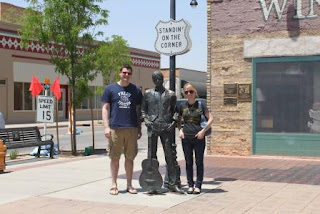Jackrabbit Trading Post: Lindsey Tries to Adopt a Life Size, Plastic Bunny
We began our morning at the Jackrabbit Trading Post, which - like Henry's Rabbit Ranch - advertises itself miles in advance with yellow "Here It Is" signs. With an embarrassing amount of excitement, I scampered from Elvis to climb atop the giant, plastic Jackrabbit outside the store with no success in convincing Joe to do the same.
Inside the Trading Post, we met Cindy Jaquez (3rd generation owner) and her daughter - an endearing teenager just learning how to greet customers and use the cash register. After purchasing a few more Route 66 coozies and magnets, Cindy handed us two passport booklets. "If you're traveling west," she said, "you can get this stamped at different stops along the way and turn it in for a prize." We left, in equal glee as we arrived, wondering what such a prize could be.
Winslow, AZ: "Another Tough Town that Refuses to Die"
We stopped next on a corner in Winslow, Arizona (and had to wait all day to write that sentence). Lost in a town with less than three thousand households, we found our way to the corner by following other erratic, out-of-state drivers and the faint sounds of Eagles' music. Surrounded by neglected front yards and businesses barely surviving, the "corner in Winslow, Arizona" is out of place with its spotless memorial and high-end souvenir shop. But no less than a dozen tourists were ambling about, taking photos of one another and singing the famous lyric over and over again. Multiply a dozen tourists for every hour of every day in the year, and that song may have single-handedly saved Winslow.
 |
| Eagles' 79 tour to Pittsburgh. Fitting. |
The Eagles released their first album in 1972, including Take It Easy, and unknowingly threw a life-line to forsaken Winslow. In 1994, a year after Travis Tritt remade the song and shot it to the top of the charts, the Standin' on a Corner Foundation - an amalgamation of local Route 66, La Posada, and "corner" enthusiasts - embarked on an ambitious plan to save the town. It rescued La Posada the same year and the hotel is thriving with business today.
 |
| La Posada Hotel. |
 |
| La Posada's beautiful gardens. |
Meteor City: The Home of Eduardo the Space Alien
About halfway through our journey, we realized that I'm really on this trip for the people (hence, our blog title). Joe is equally passionate about places - and rocks. Old ones. And holes in the ground. Big ones. So, we had to stop at the giant meteor crater in the middle of nowhere, Arizona and I'm ghost writing the remainder of this post out of love for him.
Also known as the Barringer Crater, this (500+ foot deep and 2 1/2 mile round) crater was formed over 10,000 years ago when a meteor (approximately 150 feet across) hurtled to the earth's surface. After a short video, informing us about how meteors will probably kill the human race in the near-distant future, we walked to the crater as guided by the resident "hole-in-the-ground" expert and self-described space alien, Eduardo (who told us he was traded by the aliens for Jeff Bridges in Starman).
 |
| Eduardo - Best Tour Guide Ever |
 |
| Big piece of the rock that Eduardo told us to rub for good luck. |
 |
| Joe, lookin' for John Glenn. |













































